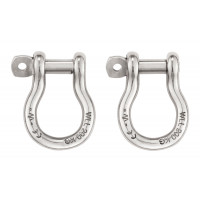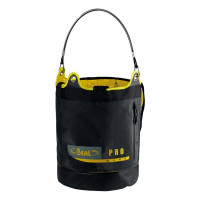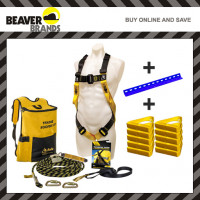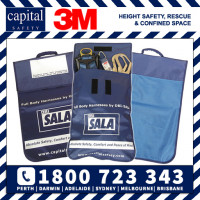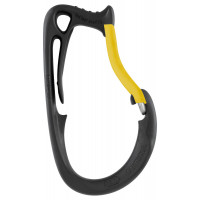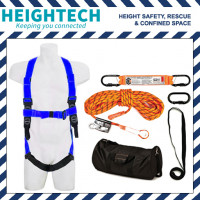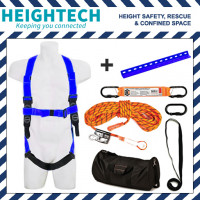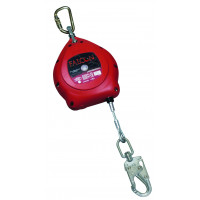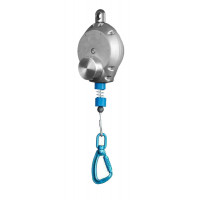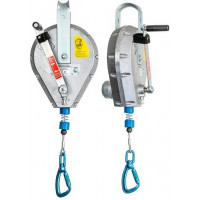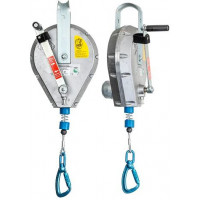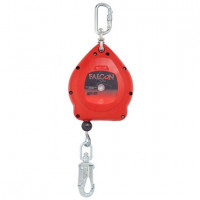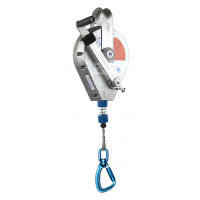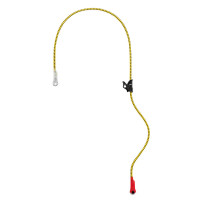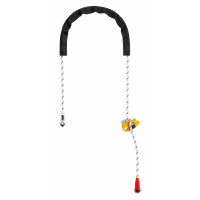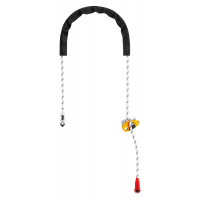Standards Australia Drafts Open for Public Comment for AS/NZS 1891 Personal Equipment for Work at Height
Comment on a Draft Standard
An important stage in the development of an Australian Standard is the Public Comment period. The Public Comment period is usually open for two to three months. Anyone who feels they have something to contribute to a Draft Standard should use the Public Comment Period to provide their view on its provisions. All comments are considered in detail by the relevant Committee and, if necessary, further drafting is undertaken. Individual feedback will not be given by the Committee on the comments provided.
AS/NZS 1891.1 - Manufacturing Requirements for Full Body Combination and Lower Body Harnesses.
This Standard was prepared by the joint Standards Australia/Standards New Zealand Committee SF-015, Personal Equipment for Work at Height, to supersede AS/NZS 1891.1—2007, Industrial fall-arrest systems and devices, Part 1: Harnesses and ancillary equipment.
The objective of this Standard is to specify requirements for the materials, design, manufacture, testing and marking of full-body, combination and lower-body harnesses designed for working at height.
The major changes in this edition are as follows:
(a) Separation of the document into three separate documents dealing with the following areas:
(i) Harness manufacture.
(ii) Lanyard and pole strap manufacture.
(iii) Ancillary equipment (under development).
(b) Alteration of the testing requirements to align with international Standards and foreseeable use while balancing the need to maintain appropriate safety margins in design.
This document is the first part of the following series of Standards dealing with this area of industrial safety:
- AS/NZS 1891.1, Personal equipment for work at height, Part 1: Manufacturing requirements for full body, combination and lower body harnesses (this Standard)
- AS/NZS 1891.2, Industrial fall-arrest systems and devices, Part 2: Horizontal lifeline and rail systems
- AS/NZS 1891.2, Supp 1, Industrial fall-arrest systems and devices, Part 2: Horizontal lifeline and rail systems,
- Supplement 1: Prescribed configurations for horizontal lifelines (Supplement toAS/NZS 1891.2—2001)
- AS/NZS 1891.3, Personal equipment for work at height, Part 3: Fall-arrest devices
- AS/NZS 1891.4, Industrial fall-arrest systems and devices, Part 4: Selection, use and maintenance
- AS/NZS 1891.5, Personal equipment for work at height, Part 5: Lanyards and pole straps
The above series of Standards are part of a suite which also includes the following:
- AS/NZS 4488.1, Industrial rope access systems, Part 1: Specifications
- AS/NZS 4488.2, Industrial rope access systems, Part 2: Selection, use and maintenance
- AS/NZS 5532, Manufacturing requirements for single-point anchor device used for harness-based work at height
This Standard is intended to be read in conjunction with Parts 4 and 5 of the AS/NZS 1891 series.
The terms “normative” and “informative” are used in Standards to define the application of the appendices to which they apply. A “normative” appendix is an integral part of a Standard, whereas an “informative” appendix is only for information and guidance.
Australian/New Zealand Standard Personal Equipment for Work at Height
Part 1: Manufacturing requirements for full body combination and lower body harnesses
Section 1 Scope and general
1.1 Scope
This Standard specifies requirements for the materials, design, manufacture, testing and marking of full-body, combination, and lower-body harnesses designed for working at height.
1.2 Application
Personal protective equipment designed exclusively for the following purposes is not covered by this Standard:
(a) Theatrical flying.
(b) Total restraint applications. (Refer to AS/NZS 1891.4.)
(c) Rescue operations.
(d) Emergency services.
1.3 Normative references
The following documents are referred to in the text in such a way that some or all of their content constitutes requirements of this document.
NOTE Documents for informative purposes are listed in the Bibliography.
- AS 2001.1, Methods of test for textiles, Part 1: Conditioning procedures
- AS 2001.4.A02, Methods of test for textiles, Method 4.A02: Colourfastness tests — Grey scale for assessing change in colour
- AS 2001.4.B01, Methods of test for textiles, Method 4.B01: Colourfastness tests — Determination of colourfastness to daylight of textile materials
- AS 2001.4.B02, Methods of test for textiles, Method 4.B02: Colourfastness tests — Colourfastness to artificial light: Xenon arc fading lamp test (ISO 105‑B02:1994, MOD)
- AS 2001.4.21, Methods of test for textiles, Method 4.21: Colourfastness tests — Determination of colourfastness to light using an artificial light source (mercury vapour, tungsten filament, internally phosphor-coated lamp)
- AS 2193, Calibration and classification of force-measuring systems
- AS 4142.3, Fibre ropes, Part 3: Man-made fibre rope for static life rescue lines
- AS/NZS 1891.4, Industrial fall-arrest systems and devices, Part 4: Selection, use and maintenance
- AS/NZS 1891.5, Personal equipment for work at height, Part 5: Manufacturing requirements for lanyard assemblies and pole straps
Download AS/NZS 1891.1 - Manufacturing Requirements for Full Body Combination and Lower Body Harnesses | Make a Comment
Heightech's Popular Safety Harnesses
-
-
-
Beaver Roofers Kit with Roof Anchor and 10 x Roof Handles
Regular Price: $389.95
NOW: $364.95
-
-
-
-
Roofer's Kit with Safety Harness, 15kN Roof Anchor and 15m Ropeline
Regular Price: $344.95
NOW: $294.95
-
Beaver B Safe Roofers Kit Tradies harness & 15m rope system.
Regular Price: $289.95
NOW: $259.95
AS/NZS 1891.3 - Fall Arrest Devices
Preface
This Standard was prepared by the joint Standards Australia/Standards New Zealand Committee SF-015, Personal Equipment for Work at Height, to supersede AS/NZS 1891.3—1997, Industrial fall-arrest systems and devices, Part 3: Fall-arrest devices.
The objective of this Standard is to specify requirements for the design and performance of fall-arrest devices which travel along a fixed or flexible anchorage line, and those which pay out an anchorage line.
This edition has removed the Australian appendices and design requirements, referring instead to relevant European and American Standards.
At the time of producing this Standard, there do not appear to be any Australian manufacturers producing fall-arrest devices. Those devices being made available in Australia are generally imported from Europe and America, whose Standards are equal or more advanced than our Australian Standard.
This Standard has been revised providing a comprehensive list of requirements which include the recognition of specific international Standards and the schedule of tests found in those Standards.
Australian manufacturers are able to follow any of the appropriate test schedules detailed in Table 1 of this Standard (AS/NZS 1891.3).
This document is the third part of the following series of Standards dealing with this area of industrial safety:
- AS/NZS 1891.1, Personal equipment for work at height, Part 1: Manufacturing requirements for full body, combination and lower body harnesses
- AS/NZS 1891.2, Industrial fall-arrest systems and devices, Part 2: Horizontal lifeline and rail systems
- AS/NZS 1891.2, Supp 1, Industrial fall-arrest systems and devices, Part 2: Horizontal lifeline and rail systems, Supplement 1: Prescribed configurations for horizontal lifelines (Supplement toAS/NZS 1891.2—2001)
- AS/NZS 1891.3, Personal equipment for work at height, Part 3: Fall-arrest devices (this Standard)
- AS/NZS 1891.4, Industrial fall-arrest systems and devices, Part 4: Selection, use and maintenance
- AS/NZS 1891.5, Personal equipment for work at height, Part 5: Lanyards and pole straps
The above series of Standards are part of a suite which also includes the following:
- AS/NZS 4488.1, Industrial rope access systems, Part 1: Specifications
- AS/NZS 4488.2, Industrial rope access systems, Part 2: Selection, use and maintenance
- AS/NZS 5532, Manufacturing requirements for single-point anchor device used for harness-based work at height
Australian/New Zealand Standard Personal Equipment for Work at Height
Part 3: Fall-arrest devices
1 Scope
This Standard specifies requirements for the design and performance of fall-arrest devices which travel along a fixed or flexible anchorage line, and those which pay out an anchorage line.
2 Normative References
The following documents are referred to in the text in such a way that some or all of their content constitutes requirements of this document.
- AS/NZS 1891.4, Industrial fall-arrest systems and devices, Part 4: Selection, use and maintenance
- EN 353, Personal fall protection equipment (series)
- EN 360, Retractable lanyards
- EN 1496, Rescue lifting devices
- ANSI Z359.4, Safety requirements for assisted rescue and self rescue system, sub systems and components
- ANSI Z359.14, Safety requirements for self-retracting devices for personal fall arrest and rescue systems
3 Definitions
For the purpose of this Standard the definitions in the AS/NZS 1891 series and those below apply.
3.1 anchor line flexible/rigid
this device may be one of the following:
- Connecting element specified for a subsystem with a guided type fall-arrester.
- A flexible line may be a synthetic fibre rope or a wire rope and is intended to secure to an upper anchor point. (Refer to ANSI Z359.)
- A rigid anchor line, connecting element to which a guided fall-arrester is attached and may be attached to a structure at intervals along its length.
3.2 anchorage line
a rigid rail or flexible line secured to an anchorage point along which a Type 1 fall-arrest device travels, or a flexible line which unreels from a fall-arrest device
3.3 anchorage point
a secure point of attachment to a structure to which a fall-arrest device or an anchorage line may be attached
3.4 arrest distance
Download AS/NZS 1891.3 - Fall Arrest Devices | Make a Comment
Heightech's Popular Fall Arrest Devices
-
Miller Falcon Type 2 Fall Arrestor 15M Stainless Steel Wire & Snaphook (1028682)
Regular Price: $1,750.00
NOW: $1,550.00
-
15m Miller Falcon Type 2 Fall Arrestor Galv Wire (10117460)
Regular Price: $1,300.00
NOW: $1,150.00
-
-
-
12m IKAR Fall Arrest Block Inertia Reel SRL Type 3 Recovery Function
Regular Price: $2,500.00
NOW: $2,250.00
-
18m IKAR Fall Arrest Block Inertia Reel SRL Type 3 Recovery Function
Regular Price: $2,828.00
NOW: $2,590.00
-
-
24m IKAR Fall Arrest Block Inertia Reel SRL Type 3 Recovery Function
Regular Price: $3,300.00
NOW: $2,650.00
AS/NZS 1891.5 - Lanyard Assemblies and Pole Straps
Preface
This Standard was prepared by the joint Standards Australia/Standards New Zealand SF-015, Industrial Height Safety Equipment, to supersede in part AS/NZS 1891.1—2007, Industrial fall-arrest systems and devices, Part 1: Harnesses and ancillary equipment.
The objective of this Standard is to specify requirements for the materials, design, manufacture and testing of lanyard assembly, pole straps and personal energy absorbers for fall-protection purposes.
Self-retracting lanyards are not covered in this Standard.
This document is the fifth part of the following series of Standards dealing with this area of industrial safety:
- AS/NZS 1891.1, Personal equipment for work at height, Part 1: Manufacturing requirements for full body, combination and lower body harnesses
- AS/NZS 1891.2, Industrial fall-arrest systems and devices, Part 2: Horizontal lifeline and rail systems
- AS/NZS 1891.2, Supp 1, Industrial fall-arrest systems and devices, Part 2: Horizontal lifeline and rail systems, Supplement 1: Prescribed configurations for horizontal lifelines (Supplement to AS/NZS 1891.2—2001)
- AS/NZS 1891.3, Personal equipment for work at height, Part 3: Fall-arrest devices
- AS/NZS 1891.4, Industrial fall-arrest systems and devices, Part 4: Selection, use and maintenance
- AS/NZS 1891.5, Personal equipment for work at height, Part 5: Manufacturing requirements for lanyard assemblies and pole straps (this Standard)
The above series of Standards are part of a suite which also includes the following:
- AS/NZS 4488.1, Industrial rope access systems, Part 1: Specifications
- AS/NZS 4488.2, Industrial rope access systems, Part 2: Selection use and maintenance
- AS/NZS 5532, Manufacturing requirements for single-point anchor device used for harness-based work at heights
Australian/New Zealand Standard Personal equipment for work at height
Part 5: Manufacturing requirements for lanyard assemblies and pole straps
Section 1 Scope and general
1.1 Scope
This Standard specifies requirements for the materials, design, manufacture and testing of lanyard assembly, pole straps and personal energy absorbers for fall-protection purposes.
1.2 Exclusions
Self-retracting lanyards are not covered by this Standard. (Refer to AS/NZS 1891.3.)
Personal protective equipment designed exclusively for the following purposes is not covered by this Standard:
(a) Theatrical flying.
(b) Total restraint applications.
(c) Emergency services.
1.3 Normative References
The following documents are referred to in the text in such a way that some or all of their content constitutes requirements of this document.
NOTE Documents referenced for informative purposes are listed in the Bibliography.
- AS 2001.1, Methods of test for textiles, Part 1: Conditioning procedures
- AS 2001.4.A02, Methods of test for textiles, Method 4.A02: Colourfastness tests — Grey scale for assessing change in colour
- AS 2001.4.B01, Methods of test for textiles, Method 4.B01: Colourfastness test — Determination of colourfastness to daylight of textile materials
- AS 2001.4.B02, Methods of test for textiles, Method 4.B02: Colourfastness test — Colourfastness to artificial light: Xenon arc fading lamp test (ISO 105‑B02:1994, MOD)
- AS 2001.4.21, Methods of test for textiles, Method 4.21: Colourfastness test — Determination of colourfastness to light using an artificial light source (mercury vapour, tungsten filament, internally phosphor-coated lamp)
- AS 2193, Calibration and classification of force-measuring systems
- AS 2321, Short-link chain for lifting purposes
- AS 3569, Steel wire ropes—Product specification
- AS 4142.2, Fibre ropes, Part 2: Three-strand hawser-laid and eight-strand plaited
- AS 4142.3, Fibre ropes, Part 3: Man-made fibre rope for static life rescue lines
- AS/NZS 1891.3, Industrial fall-arrest systems and devices, Part 3: Fall-arrest devices
- AS/NZS 1891.4, Industrial fall-arrest systems and devices, Part 4: Selection, use and maintenance
- ISO 9227, Corrosion tests in artificial atmospheres — Salt spray tests
- SAE J211-1, Instrumentation for impact test — Part 1 — Electronic Instrumentation
- US Federal Test Method Standard 191A
1.4 Definitions
For the purpose of this Standard, the definitions below apply.
1.4.1
adjuster
a device, used to fit and adjust harnesses on the wearer or the length of a lanyard, which is not required to sustain the full force of a fall-arrest
1.4.2
adjuster creep
the slippage of the material through the lanyard when under load or use
1.4.3
attachments
a load-bearing, openable element which enables the user to assemble a system in order to link themselves directly or indirectly to an anchor
1.4.4
class Q connector (tube nut connector)
a connector having a gate comprising a captive threaded sleeve which tightens over a thread on the opposite side of the opening or gate. The threaded sleeve enabling it to be tightened with a spanner forming a more permanent link than a karabiner
1.4.5
connector
openable device used to connect components, which enables the user to assemble a system in order to link themselves directly or indirectly to an anchor
Note 1 to entry: Screw gate karabiners are no longer supported by this standard
1.4.6
fall-arrest device
a self-locking device intended to arrest the free descent of a falling person
1.4.7
fall-arrest harness adjusters
these comprise devices used to fit and adjust harnesses on the wearer and are not required to sustain the full force of a fall-arrest. The category excludes buckles and adjusters for pole straps rating a length adjusting device
1.4.8
free-fall, free-fall-arrest
a fall or the arrest of a fall where the fall distance before the fall-arrest system begins to take any loading is in excess of 600 mm either vertically or on a slope on which it is not possible to walk without the assistance of a handrail or hand line
1.4.9
karabiner (locking)
a connector which has a spring-loaded gate with face and side load latch strength of 16kN, with a secondary locking mechanism, designed to connect to other connectors or attachment points
Note 1 to entry: For further description, refer to AS/NZS 1891.4
Note 2 to entry: Screw gate karabiners are no longer supported by this Standard
1.4.10
lanyard assembly
an assembly of a line and its components, in fixed or adjustable length, which will enable a connection between a harness and an anchorage and which will absorb energy in the event of a fall
1.4.11
leading edge
the edge, or unprotected side of a floor, roof or formwork where levels change
1.4.12
leading edge lanyards
a lanyard assembly having leading edge capability, designed for use in applications where falls may occur over edges (see Appendix H)
1.4.13
limited free-fall
a fall or the arrest of a fall where the fall distance before the fall-arrest system begins to take any loading is less than 600 mm either vertically or on a slope on which it is not possible to walk without the assistance of a handrail or hand line
1.4.14
personal energy absorber
a device or component used in conjunction with a harness which by design reduces the deceleration force imposed by a suddenly arrested fall
1.4.15
pole strap
a work positioning strap designed to be placed around a pole or other vertical structural member and attached at two points, one on each side of a harness, whilst the wearer is working on the pole or structural member
1.4.16
pole strap adjuster
the pole strap may be fitted with a load-bearing length adjuster designed to withstand the fall force in the case of a fall and designed so the length can be conveniently adjusted to allow the pole strap harness combination to support the wearer in a working position. If provided, the adjuster shall selflock securely and shall not abrade or otherwise damage the strap. Provision shall be made to retain the pole strap at the extremity of adjustment
1.4.17
pull-out force
a test to determine the minimum force required to initiate permanent deformation of the personal energy absorber
1.4.18
restrained fall
a fall or the arrest of a fall where the person suffering the fall is partially restrained by a restraining device such as a pole strap under tension
1.4.19
shall
indicates that a statement is mandatory
1.4.20
should
indicates a recommendation
1.4.21
snap hook
a connector attached to a line or lanyard assembly comprising a hook-shaped body with a self-closing, self-locking gate with face and side load latch strength of 16kN designed to receive a compatible attachment point able to sustain the full loading of a fall-arrest
1.4.22
tube nut connector
a connector having a gate comprising a captive threaded sleeve which tightens over a thread on the opposite side of the opening or gate. The threaded sleeve enabling it to be tightened with a spanner forming a more permanent link than a karabiner
1.4.23
work positioning
use of a system that enables a person to work supported in a harness under tension in such a way that a fall is prevented
1.5 Selection, use and maintenance
Users of any item of equipment specified in this Standard are warned of the importance of consulting both AS/NZS 1891.4 and manufacturers’ recommendations before selecting and using that item for any purpose and further ensuring that persons using the equipment are competent to do so. Incorrect selection for a purpose or misuse of an item can result in user safety being seriously compromised.
Download AS/NZS 1891.5 - Lanyard Assemblies and Pole Straps | Make a Comment
Heightech's Popular Lanyards and Pole Straps
-
-
Petzl 2.5m Microflip Arborist Work Positioning Lanyard (L33 025)
Regular Price: $445.00
NOW: $389.95
-
-



